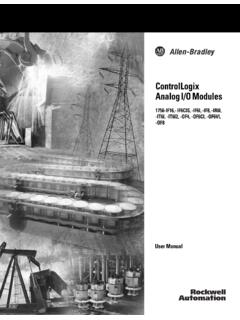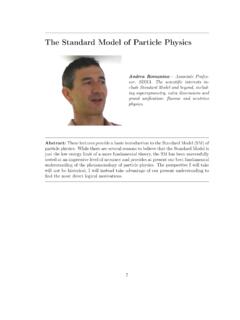Transcription of OPTICAL FIBER COMMUNICATION - SLAC National …
1 OPTICAL FIBER COMMUNICATIONZ afarYasinOUTLINE-Introduction about OPTICAL Characteristics of FIBER Optics COMMUNICATION propagation in an OPTICAL Analysis for Single Mode Analysis for Multimode Plasmon FIBER Surface Plasmon Resonance waveguide of cylindrical geometry with core and cladding of suitable index of core > refractive index of claddingMain MotivationTo meet demand of increase in the telecommunication data transmission. claddingPhysical Principle input light output light Total internal reflection (critical angle, using Snell s law).
2 Core Main AdvantagesOPTICAL FIBER COMMUNICATION SYSTEM Higher bandwidth (extremely high data transfer rate). Less signal degradation. Less costly per meter. Lighter and thinner then copper wire. Lower transmitter launching power. Less susceptible to electromagnetic interference.
3 Flexible use in mechanical and medical imaging Applications Telecommunications. Sensors. FIBER Lasers. Bio-medical. Automotive and many other Material Choice? 1950 s used cladding FIBER : (Nobel Prize 2009)-Good image properties demonstrated for 75 cm long FIBER [Nature 173,39 (1954)].-Application found use in medicine as gastroscopes, endoscopes of Laser in 1960 s , but didn t work for OPTICAL COMMUNICATION due to attenuation problem!
4 -In 1964 critical theoretical suggestion by, Charles K. Kao and Charles Hockam:-For long range COMMUNICATION system the loss limit was set to 20 dB/Km (was ~ 1000 db/Km or higher at that time!).-Pure form of Silica, by reducing impurities , the OPTICAL losses were not due to glass itself, but impurities in met by doping titanium in fused core and pure fused Silica in cladding [Appl. Phys. Lett. 17, 423 (1970)].-Today the lower limit is below and Plastic clad Silica , as well few other OPTICAL fibers materials (useful for some applications), has been loss in glass as function of time.
5 (Source: Nagel S.(1989). OPTICAL FIBER : The expanding medium. IEEE Circuits Devices Magaz. March, 36.) Silica and Plastic as FibreOptic MaterialsSilica Fibers-Both core and cladding are of pure SiO2 or fused or Phosphorus to increase the index of or Flourineto decrease the index of fibers mainly used due to their low intrinsic absorption at wavelengths of other remaining impurities cause attenuation and Fibers-Plastic core and plastic (most commonly used). -Flexible and Light. Attenuation Spectrum of Silica used in short distance applications.
6 (Source: Miya,T., , Thosaka, and T Miyashita , An ultimate low loss single mode FIBER at mm, Electron. Letts, Vol15, 106, 1979)Plastic-clad Fibers- glass as core and plastic as is better? (Plastic or Silica)-Plastic less expensive, flexible, is larger in diameter, so easy to connect across is less efficient then has more attenuation, and less bandwidth making it more suitable for shorter distances. Attenuation Spectrum of Plastic Fibers.
7 (Source: )Main Characteristics of OPTICAL Transmission Medium-The ray entering the acceptance angle will be guided along the angle is measure of the light-gathering power of the Numerical Aperature(NA) mean higher coupling from source to FIBER , and less losses across the OPTICAL power reaching the receiver. NA = (n12 -n22) Power received can be related with the transmitted as: dB = -10 log10(power out / power input).
8 -Lower attenuation mean greater spacingand less cost of the COMMUNICATION Causes of Attenuation?ScatteringDue to interactions of photons with FIBER (Intrinsic+Extrinsic)By FIBER itself (intrinsic) or due to impurities of water and metal, such as iron, nickleand chromium (extrinsic).Bending and Geometrical Imperfections-Due to physical stress on interface irregularities, diameter variations and Multimode Fibers-Light propagated in OPTICAL FIBER in form of distributions of EM fields do not change with of Modes?
9 -V number (normalized frequency) define number of possible modes for a FIBER :V= (2* *a*NA) / where a is radius of FIBER , and is wavelength of single mode propagation, V< and Non-uniformly doped Mode Fibers-With the primary degrees of freedom of core cladding diameter and the difference of refractive indices between them they can be optimized for attenuation and propagation can be studied using geometrical optics. MultiModeFibers -Different modes can exist simulatenouslyon the same upon profile shape they can be: Different Modes of OPTICAL Fibers(Source.)
10 Multimode Step IndexMultimode Graded Index-The core index decreases like a parabolic-like law from the axis to the core cladding to minimize the intermodal dispersion effect (without significantly reducing the numerical aperatureor the coupled power).FibreOptics ModesElectromagnetic Waves propagating in an OPTICAL FIBER consist of :-TE and HE EH and HE modes contain both axial electric and magnetic fields. -The mode can be EH or HE depending upon which component contribute more to the axial from Maxwell equations.








